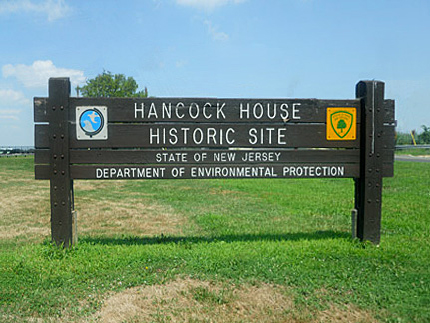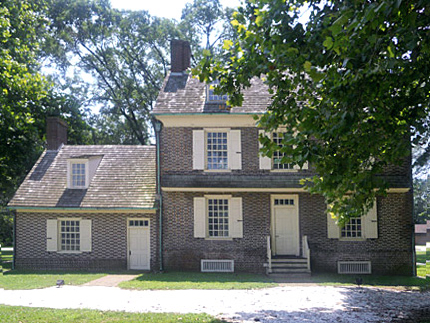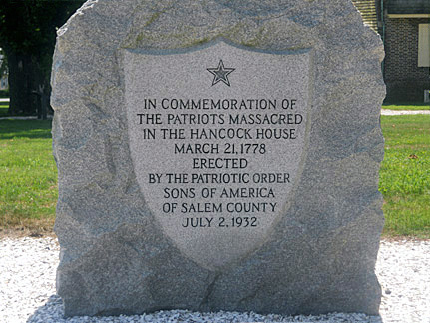



Hancock House
3 Front St.
Map / Directions to the Hancock House
For information about visiting the Hancock House, see the Hancock House Website
The Hancock House and the Hancock Family[1]
Note that this Hancock family was not related to the famous John Hancock who signed the Declaration of Independence.
The Hancocks were a prominent Salem County family of Quakers. The Hancock House sits on property that was owned by the Hancock family for over two-and-a-half centuries. The property was purchased in 1675 by William Hancock. It was passed on to his nephew John, and then to John's son William. The house was built in 1734 by this William and his wife Sarah. The letters HWS (for Hancock, William, Sarah) and the date 1734 are visible in the brickwork pattern on the side of the house. William served as Salem County Justice of the Peace, and he also served in the Colonial Assembly for two decades.
When William died in 1762, the house was inherited by his son, also named William. He followed in his father's footsteps in the political and legal fields by serving in the Colonial Assembly, and as the judge for Salem County at the Salem County Courthouse.
Hancock's Bridge, which gave this town its name, was located about one hundred yards from the front of the Hancock House. The bridge had been built by Judge Hancock's grandfather in 1709.
As Quakers, the Hancock family were pacifists, and so did not wish to take part in the fighting of the Revolutionary War. They could not have foreseen that despite their pacifist beliefs, the violence of the war would come to their own house, as it did on March 21, 1778.


The Massacre at Hancock House - March 21, 1778 [2]
In March 1778, a group of about 1500 British troops under the command of Charles Mawhood occupied the town of Salem. Their objective was to confiscate cattle, hay and corn for use by the British forces who were then across the Delaware River in Philadelphia. (See the Salem page for more information about the occupation of Salem.)
Local citizens had moved some of the cattle south of Salem, past Alloways Creek, to keep it from the British. Alloways Creek extends about thirty miles inland from the Delaware River, creating a natural southern boundary that could only be crossed at three bridges in the area: Hancock's Bridge, Quinton's Bridge about 4 miles west, and Thompson's Bridge another five miles farther west. Salem and Cumberland County militiamen took positions at the bridges to stop the British from moving past them.
The British made an attack on Quinton's Bridge on March 18. Seventeen miltiamen were killed, but the militia defense held and the British could not get over Quinton's Bridge.
Meanwhile, the militia at Hancock's Bridge decided that it would be best to damage Hancock's Bridge to prevent the British from crossing here. Thinking they had protected themselves by cutting off the approach by the bridge, about twenty militiamen retired for the night of March 20 in the Hancock House. Unfortunately, this false sense of security left them open to an unexpected plan of attack by the British.
Colonel Mawhood sent a group of about 300 British troops under the command of Major John Graves Simcoe to attack the militia here. Unable to cross at the bridge, they used a different plan of attack which would give them the element of surprise. While the militiamen slept in the Hancock House, Simcoe's men crossed Alloways Creeks in boats several miles downriver, and then marched to the Hancock House under cover of darkness.
Early in the morning of March 21, Major Simcoe's troops surprised the militiamen who were staying the night at the Hancock House. The attack was made about 5 a.m., before the sun rose. Simcoe's men attacked in the dark, going through the front and back doors at the same time. They killed about ten of the militiamen inside, and wounded about five more, by bayoneting them in their sleep. The owner of the house, William Hancock, was mortally wounded in the attack and died a few days later.
Major Simcoe's men then repaired Hancock's Bridge by laying wooden planks over it, allowing other British troops on the other side of Alloways Creek to cross.
Later that day, as news of the massacre spread through the local citizenry, British Colonel Mawhood sent a letter to Colonel Hand stating that if the local militia were willing to let the British take their supplies uncontested, they would leave and pay for the supplies. He went on to state the alternative, in chilling language that shows the deadly seriousness of the situation faced by the local citizens: [3]
Colonel Mawhood, commanding a detachment of the British army at Salem, induced by motives of humanity, proposes to the militia at Quintins Bridge and the neighbourhood, as well officers as private men, to lay down their arms and depart each man to his home: On that condition he solemnly promises to re-embark his troops without delay, doing no further damage to the country; and he will cause his commissaries to pay for the cattle, hay, and corn, that have been taken, in sterling money.
If, on the contrary, the militia should be so far deluded, and blind to their true interest and happiness, he will put the arms which he has brought with him into the hands of the inhabitants well-affected, called tories, and will attack all such of the militia as remain in arms, burn and destroy their houses and other property, and reduce them, their unfortunate wives and children to beggary and distress; and to convince them that these are not vain threats, he has subjoined a list of the names of such as will be the first objects to feel the vengeance of the British nation.
[A list of twenty seven names accompanied the letter.]
Given under my hand at Head-Quarters, at Salem, the twenty-first day of March, 1778.
C. Mahwhood, Colonel
Colonel Hand responded the following day in a remarkable letter which bristles with outrage, not only at the massacre and the threats on the property of militiamen, but of Mawhood's claim to be "induced by motives of humanity." [4]
SIR,
I have been favoured with what you say humanity has induced you to propose. It would have given me much pleasure to have found that humanity had been the line of conduct to your troops since you came to Salem. Not only denying quarters, but butchering our men who surrendered themselves prisoners in the skirmish at Quintin's Bridge last Thursday, and bayonetting yesterday morning at Hancock's Bridge, in the most cruel manner in cold blood, men who were taken by surprize, in a situation in which they neither could nor did attempt to make any resistance, and some of whom were not fighting men; are instances too shocking for me to relate, and I hope for you to hear.—The brave are ever generous and humane.—After expressing your sentiments of humanity, you proceed to make a request which I think you would despise us if we complied with. Your proposal, that we should lay down our arms, we absolutely reject. We have taken them up to maintain rights which are dearer to us than our lives, and will not lay them down, 'till either success has crowned our cause with victory, or like many ancient worthies contending for liberty, we meet with an honourable death. You mention that if we reject your proposal, you will put arms into the hands of the tories against us; we have no objection to the measure, for it would be a very good one to fill our arsenals with arms.—Your threats to wantonly burn and destroy our houses and other property, and reduce our wives and children to beggary and distress, is a sentiment which my humanity almost forbids me only to recite, and induces me to imagine I am reading the cruel order of a barbarous Atila, and not of a Gentleman, brave and polished with a genteel European education—To wantonly destroy, will injure your cause more than ours—it will encrease your enemies and our army.—To destine to destruction the property of our most distinguished men, as you have done in your proposals, is, in my opinion, unworthy a generous foe; and more like a rancorous feud between two contending Barons, than a war carried on by one of the greatest powers on earth, against a people nobly struggling for Liberty—a line of honour would mark out that these men should share the fate of their country—If your arms should be crowned with victory, which God forbid, they and their property will be entirely at the disposal of your Sovereign. The loss of their property, while their persons are out your power, will only make them desperate; and, as I said before, encrease your foes and our army; and retaliation upon tories and their property is not out of our power. Be assured that these are the sentiments and determined resolution, not of myself only, but of all the officers and privates under me.
My prayer is, Sir, that this answer may reach you in health and great happiness.
Given at Head-Quarters, at Bridge, the twenty-second day of twenty-second day of March, 1778.
Elijah Hand, Colonel
The British troops in Salem went back to Philadelphia by the end of March, taking the cattle, hay and corn they had confiscated. Before they left, they did carry out their threats on the property of men listed in the letter. See the Holmeland and the Salem County Historical Society entries on the Salem page for examples of this.
Hancock House is now a State Historic Site, and is open for tours. The property includes historic plaques about the story. For information about visiting the Hancock House, see The Hancock House Website
Directly across Front Street from the house is the site where Hancock's Bridge crossed Alloways Creek, which has its own group of historic markers. (See entry below.)
SITE OF HANCOCK'S BRIDGE
Hancock's Bridge Site
Front St.
Across from the Hancock House
Map / Directions to Hancock's Bridge SiteAcross the street from the Hancock House is the site of the original Hancock's Bridge. It was a wooden bridge built in 1709 by John Hancock and others. Over the years, the original wooden Hancock's Bridge was replaced by a series of other wooden bridges at this site. The final wooden bridge to cross here was built in 1847; it was replaced by an iron bridge in 1886. The modern bridge which crosses Alloways Creek today (partially visible through the fence in the right side of the first photo above) was built in 1952-1953. [5]
Several informational plaques are located here. They give information about the history of the area and bridges, as well as the land and wildlife around Alloways Creek.
1. ^ Information about the Hancock family and house was drawn mainly from:
Hancock House State Historic Site brochure, available as a PDF at the State of New Jersey Department of Environmental Protection website here• Those interested in the architectural details of the house can find some additional information in the National Register of Historic Places Nomination Form for the Hancock House
Available as a PDF on the National Park Service website here2. ^ Information about the events surrounding the Massacre at the Hancock House was drawn from several sources, including:
• John Graves Simcoe, Simcoe's Military Journal (New York: Bartlett & Welford, 1844) pages 46 - 54
Available to be read at Google Books here
▸ John Graves Simcoe served as a Major under Colonel Mawhood. Simcoe gives considerable detail about the military actions and manoeuvres of his troops. However, his account is written to downplay the harshness of the occupation. This is particularly noticeable in his account of the militiamen who were killed at Hancock House, where Simcoe does not mention that they were bayoneted in their sleep.• Robert Gibbon Johnson, An Historical Account of the First Settlement of Salem, in West Jersey (Philadelphia, Orrin Rogers, 1839) Pages 147 - 163
For a table of
3. ^ Colonel Mawhood letter to Colonel Hand, March 21, 1778
Reprinted in:
Francis B. Lee, Editor Archives of the State of New Jersey, Second Series, Vol II (Documents Relating to the Revolutionary History of the State of New Jersey / Extracts from American Newspapers relating to New Jersey) (Trenton: John L. Murphy Publishing Company, 1903) Page 168
Available to be read at the Internet Archive here
▸ The twenty seven names listed were:
Information about some of these men can be found in the entries on the Salem page of this website.4. ^ Colonel Hand letter to Colonel Mawhood, March 22, 1778
Reprinted in:
Francis B. Lee, Editor Archives of the State of New Jersey, Second Series, Vol II (Documents Relating to the Revolutionary History of the State of New Jersey / Extracts from American Newspapers relating to New Jersey) (Trenton: John L. Murphy Publishing Company, 1903) Pages 169 - 170
Available to be read at the Internet Archive here5. ^ "Old Bridges at this Location" plaque at the Hancock's Bridge site